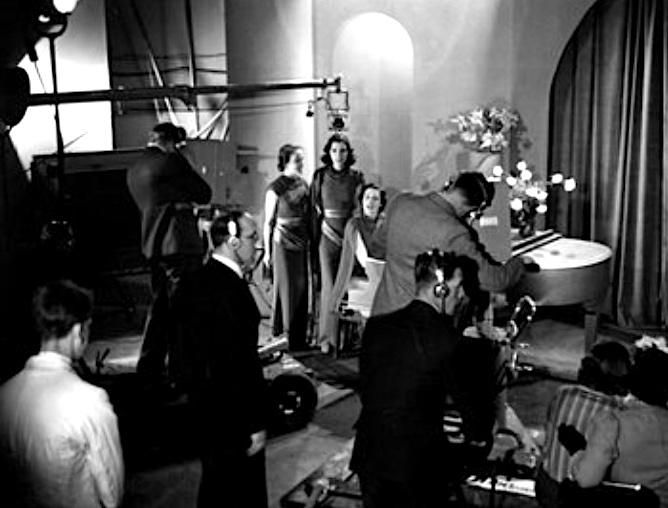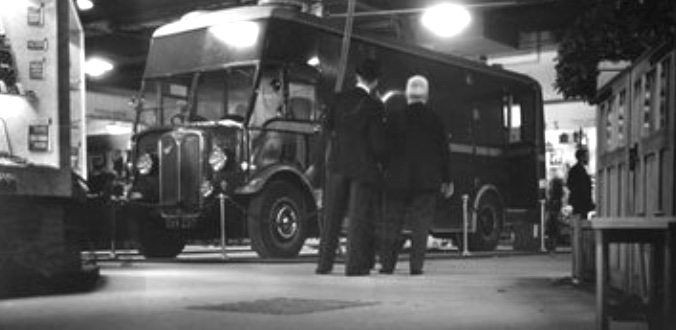OTD in early British television: 14 April 1938

John Wyver writes: At one minute past 3pm on the afternoon of Thursday 14 April 1938, Alexandra Palace switched over to a feed from a studio built inside the Ideal Home Exhibition. In a first 10-minute visit to Olympia, Jasmine Bligh interviewed actor and singer Yvonne Arnaud, the close harmony group trio The Cavendish Three perfomed ‘I double dare you’ at the piano, and accompanied by Kay Cavendish, Gracie Fields sang ‘Sally’ and ‘Little Old Lady’ (above).
Later that afternoon, as well as that evening Picture Page visited the BBC’s outside broadcast set-up at the show, and broadcasts from Olympia dotted the schedules on Saturday (but since it was the Easter weekend, not Good Friday or Easter Sunday), and then from Monday to Thursday the following week.
At a time when viewers were still far more likely to encounter television in an exhibition, viewing room or bar rather than in a home (there were perhaps 5,000 families with sets across London), the BBC committed significant resources to these broadcasts aligning the medium with domestic modernity.

Along with ‘Our Gracie’ and The Cavendish Trio (above), the BBC’s temporary studio at Olympia hosted Alfredo and his Gypsy Orchestra, Patricia Rossborough at the piano, comedian Paddy Browne, and singer Greta Gaye. There was a fashion parade and a keep-fit demonstration by the Women’s League of Health and Beauty, introduced by Olympic champion Harold Abrahams.
And there was more domestic modernity with demonstrations of a vacuum cleaner, a mixing machine, a creasing machine and a knife sharpener, as well as an introduction to ‘Grandmamma’s Ideal Home’ by designer Christine Veasey, later founder of the magazine Pins and Needles.
Many of the purportedly labout-saving devices were demonstrated by announcer Jasmine Bligh and Mrs Florence Scott, who was billed as playing the ‘typical and topical housewife’. With such displays, the process was underway by which, as historian of the domestic set Emily Rees has identified, ‘[t]elevision, from the interwar period onwards, became part of the imaginary of what the modern home looked like and the role that consumer technologies played within this.’
For the Olympia broadcasts, the BBC constructed a large, brightly-lit, fully-operational glass-walled studio, a set designed by AP’s Peter Bax, and an adjacent make-up room, which also had a glass wall. Here was a dazzling spectacle of transparency and electricity, drawing together two of the key elements of pre-war domestic modernity. A mobile scanner parked backstage (below) provided transmission facilities.

In addition to being sent to AP for re-transmission, programmes produced in the studio could be viewed on nearby receivers set up by six manufacturers. ‘Perhaps the most important fact about the Ideal Home Exhibition,’ wrote critic L. Marsland Gander, ‘was that for the first time in this country television was demonstrated to the public with real showmanship, as it has been for several years both in Paris. and Berlin.’
In her book Spectacular Television, Helen Wheatley has written about television being at the centre of a ‘narrative of consumer aspiration and affordable luxury’ represented by the Ideal Home Exhibition, with a particular emphasis on bringing spectacle from the world elsewhere into the home. As she noted,
In the foreward to the 1938 Exhibition catalogue, television is described as a ‘miracle the future effects of which none can adequately foresee’ and visitors are invited to ‘exercise your judgement upon this great achievement and to speculate about the future in your own home when the world’s events are whirled before you at your fireside in colour’…
At the Ideal Home Exhibition, an encounter with television was frequently figured as an encounter with the spectacle of modernity.
Despite all of the Television service’s efforts at Olympia, however, sales of television receivers remained stubbornly slow in the first half of 1938, and it was only after September’s Radiolympia, which was more tichtly focussed on broadcasting, that manufacturers saw hopeful signs of consumers beginning to embrace the medium. The absence of a noticeable uptick in sales may have been a key reason, combined with the ever-tighter television budget in 1939, that the BBC had next-to-no presence at the final pre-war Ideal Home Exhibition.
Leave a Reply